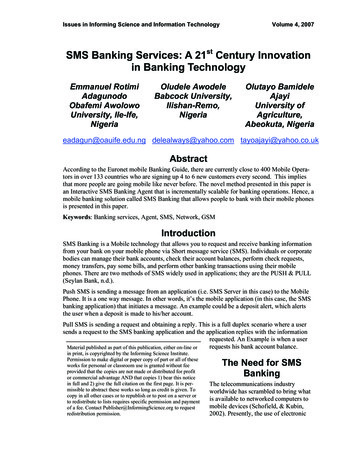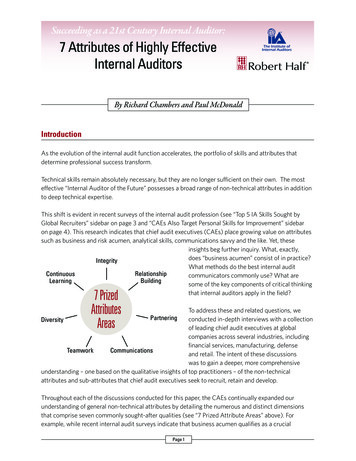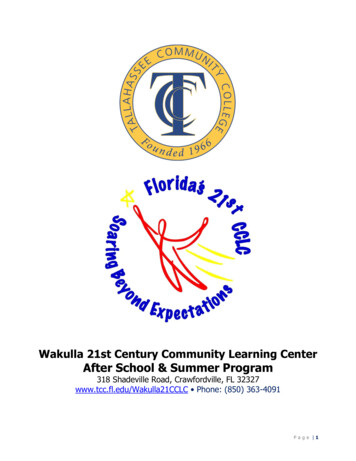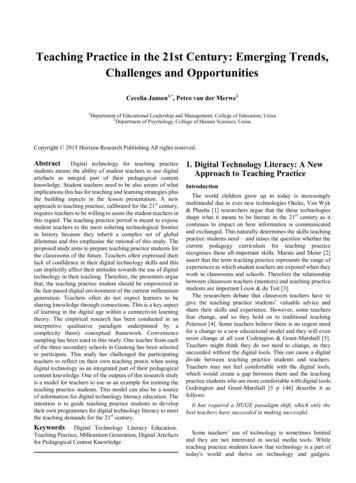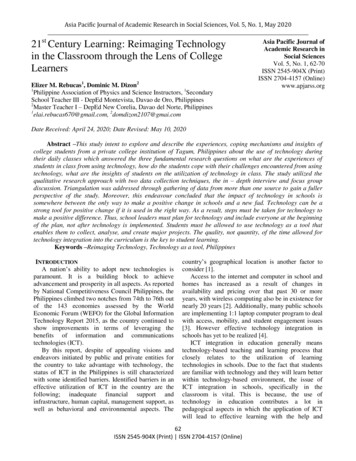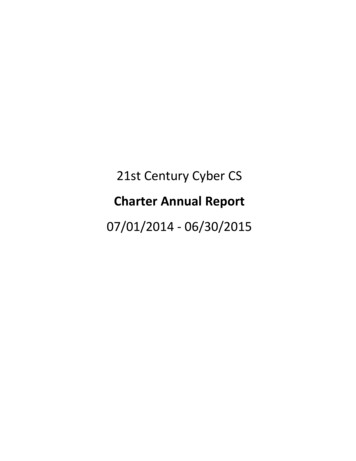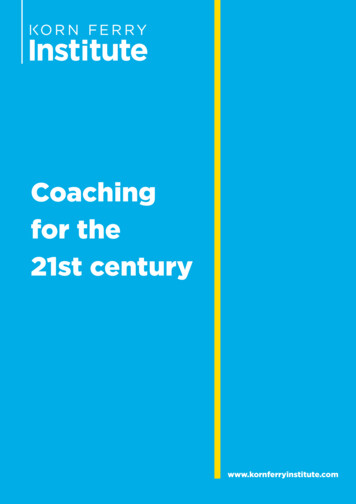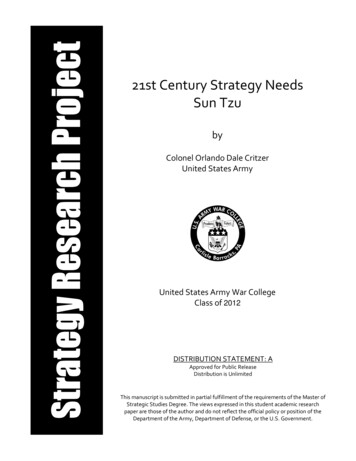
Transcription
21st-Century Human ResourceManagement StrategicPlanning and Legal IssuesPartI123The New Human ResourceManagement ProcessStrategy-Driven HumanResource ManagementThe Legal Environment andDiversity Management
1The NewHuman ResourceManagementProcessLearning OutcomesAfter studying this chapter you should be able to:1.1Identify the difference between the traditional view ofHuman Resource Management and the 21st-century view1.2Describe the major HRM skill sets1.3Discuss the line manager’s HRM responsibilities1.4Identify and briefly describe the major HRM discipline areas1.5Explain the Practitioner’s Model for HRM and how it applies tothis book1.6Define the following terms:Human resourcesEmployee engagementCost centerRevenue centerProductivity centerProductivityEffectivenessEfficiencyJob satisfactionTurnoverAbsenteeismSustainable competitiveadvantageInformation AgeKnowledge workerTechnical skillsHuman relations skillsConceptual anddesign skillsBusiness skillsLine managerStaff managerSociety for HumanResource Management(SHRM)
Chapter 1 OutlineWhy Study Human Resource Management?HRM Past and PresentPast View of HRMPresent View of HRM21st-Century HRMHRM ChallengesThe HRM Strategic ViewTechnology and KnowledgeLabor DemographicsProductivity and Competitiveness Through HRMHRM SkillsTechnical SkillsHuman Relations SkillsConceptual and Design SkillsBusiness SkillsLine Managers’ HRM ResponsibilitiesLine Versus Staff ManagementMajor HR Responsibilities of Line ManagementStaffingTraining and DevelopmentEmployee RelationsLabor and Industrial RelationsCompensation and BenefitsSafety and SecurityEthics and SustainabilityHRM CareersThe Society for Human Resource ManagementOther HR OrganizationsProfessional LiabilityThe Practitioner’s Model for HRMThe ModelSections of the ModelTrends and Issues in HRMTechnology and High-Performance Work SystemsIncreasing GlobalizationEthical Issues—Reverse DiscriminationHR Managers’ Responsibilities: Disciplines Within HRMThe Legal Environment: EEO and Diversity ManagementA.Employee and Labor Relations (required)4. Employee engagement5. Employee involvement6. Employee retention20. AttendanceB.Employment Law (required)22. Professional liabilityD.Organization Development (required)5. Improving organizational effectiveness6. Knowledge management9. Ongoing performance and productivity initiatives10. Organizational effectivenessH.Strategic HR (required)6. Internal consulting (secondary)9. Ethics (integrated)11. Organizational effectivenessCase 1-1. Welcome to the World of 21st-Century HRMSHRMHR CONTENTSee Appendix A: SHRM2010 CurriculumGuidebook for thecomplete list
4PART I: 21ST-CENTURY HUMAN RESOURCE MANAGEMENT STRATEGIC PLANNING AND LEGAL ISSUESHRM Is a Profession!In my personal opinion, the increase in employer requirements for professional certification exemplifies the transition in Human Resource Management from record keeperto strategic partner status. I’m glad I was encouraged tocertify as soon as possible. The investment in certificationpaid off in tangible proof of expertise in the body of knowledge deemed essential for work in Human Resources,and helped me advance my employment opportunities.Actually, my professional progress was set in motionwith membership in professional HR organizations.First I became a Society for Human Resource Management (SHRM) student member, which provided access toSHRM’s website— valuable for research while I was a college student, and still an often used resource in my work.Next, my involvement spread to the local HR association.The chapter meetings provide excellent opportunities tonetwork, swap “best practice” policies, and learn fromcolleagues. It was here that I discovered the HR Certification Institute training classes. I am still good friends withmany of the people I met during those classes. In fact, thepeople who invest in certification are the ones who tend tobecome more involved in their profession and, by extension, to become more successful as well.I, Cindy Wright, invite you to join me throughout this textbook as we explore real-life HR situations highlightingimportant information from each chapter. Continue reading Chapter 1 to discover more about Human ResourceManagement as a profession.v v vCindy came late to the Human Resources profession,and perhaps that explains some of her passion for thefield. As she explains: “It’s not often that one is luckyenough to be able to decide asan adult exactly what it is you reallywant to do and then go out anddo it.” Bringing her backgroundexperience as an involved parent,community volunteer, and family business manager to bear onher education, Wright graduatedsumma cum laude with a BusinessAdministration degree, HR emphasis. Cindy tested for herHuman Resource Certification Institute (HRCI) Certification as a Professional in Human Resources (PHR) at herinitial date of eligibility because she believes certification is acrucial element of professionalism.Cindy’s first position as a benefits specialist for a Caterpillardealer with 500 employees allowed her to conduct the company’s first ever employee benefit satisfaction survey andrevamp a paid time off arrangement for the hourly workers as aresult. After further employment as a benefits administrator forseven thousand telecommunication’s retirees, she has shiftedto an HR Generalist position with Saxon Drilling, a gas welldrilling company employing just under 500 workers.Besides membership in the profession’s nationalorganization—the Society for Human Resource Management(SHRM), Wright has been active in the local affiliated chapter—theCentral Arkansas Human Resources Association (CAHRA).Wright serves as Vice President of Administration for the chapter’s Board as well as Chair of the College Relation’s Committee. She was recognized by her peers with the “Rising Star”award for her work in creating a student chapter membership.Currently involved in organizing a CAHRA satellite chapter inConway, AR, Wright’s mission is to provide assistance to others interested in entering into and advancing within the HumanResources profession.WHY STUDY HUMANRESOURCE MANAGEMENT?It’s natural at this point to be thinking, “What can I get from this book?” or “What’s in it for me?”These questions are seldom asked or answered directly. But they should be answered.1 Success inour professional and personal lives is about creating relationships,2 and students understand theimportance of relationships.3 So the short answer is that the better you can work with people—and this is what most of this book is about—the more successful you will be in your personal andprofessional lives as an employee, a manager, or a Human Resource Manager.Today’s students want courses to have practical relevance.4 So that is the focus of thisbook; we designed it to be the most relevant “how to” book you ever used. As indicatedby its subtitle, “Functions, Applications, and Skill Development,” this book uses a threepronged approach, with these objectives:
Chapter 1: The New Human Resource Management Process 5 To teach you the important functions and concepts of Human Resource Management (HRM) To develop your ability to apply the HRM functions and concepts through criticalthinking To develop your HRM skills in your personal and professional livesThe book offers some unique features to further each of these three objectives, as summarized in Exhibit 1-1.Let’s go on to the longer answer to why we study HRM. Human Resource issues areemerging as some of the most prominent concerns for owners and managers.5 You’ve probably heard buzzwords floating around about managers—and particularly Human ResourceManagers—needing to be more strategic, business focused, customer focused, and generallyin tune with the overall operational success of the organization.6 Think about it for a minute.What is happening in today’s business environment that might be causing Human ResourceManagers to rethink their way of doing business? One of the primary items that is causingthis process of rethinking management is that there is much greater competition within mostindustries today compared to 20 or 30 years ago.7 As a result, Human Resource Managers aswell as Operational Managers have been forced to think in more strategic terms about howtheir organization can win against their competitors by utilizing their human resources.8One simple fact is that, in the 21st-century organization, human resources—the peoplewithin an organization—are one of the primary means of creating a competitive advantagefor the organization, because management of human resources affects performance.9 Whyis this? It’s simply because most organizations of comparable size and scope within the sameindustry generally have access to the same material and facilities-based resources. This beingthe case, it’s very difficult to create a competitive advantage based on material, facility, or othertangible or economic resources. What this leaves is people. If the organization can manage itspeople (human resources) more successfully than its competitors can, if it can get employeesinvolved in the day-to-day success of the organization, it has a much greater chance of beingsuccessful—with the term successful defined as being more productive and more profitable thanthe competition. Managers are responsible for getting the job done through employees,10 sothe organization’s human resources are its most valuable resource.11 (As you can see, there is aSHRM Guide box next to this section. We will explain them in the sixth section of this chapter.)Companies who fall “in the top 10% on employee engagement beat their competitionby 72% in earnings per share during 2007–08.”12 Also in a 2009 study it was shown that“during a span of 12 months, companies with high levels of engagement outperformedExhibit 1-1Features of This Book’s Three-Pronged ApproachFeatures That Present HRM Functions andConcepts Learning Outcome statementsKey termsStep-by-step behavior modelsChapter summaries with glossariesReview questionsFeatures to Apply the HRM Functions andConcepts That You Learn Opening thoughtsOrganizational examplesWork ApplicationsApplying the ConceptsCasesVideosFeatures That Foster Skill Development Self-AssessmentsCommunication Skills questionsSkill Builder exercisesSHRMGuide – A:5 Employee involvementSHRMGuide – A:4 Employee engagement
6PART I: 21ST-CENTURY HUMAN RESOURCE MANAGEMENT STRATEGIC PLANNING AND LEGAL ISSUESWORKAPPLICATION 1-1How can this course helpyou in your personal andprofessional lives? What areyour goals, or what do youwant to get out of this course?LO 1.1Identify the differencebetween the traditionalview of Human ResourceManagement and the21st-century view.those with less engaged employees in operating income, net income growth rate andearnings per share growth rate.”13 In this context, we define engaged employees as thosewho understand what they need to do to add value to the organization and are satisfiedenough with the organization and their roles within it to be willing to do whatever isnecessary to see to it that the organization succeeds. While employee satisfaction (whichwe will talk about at length later) can be a part of engagement, the concept of employeeengagement is much larger. It is a combination of both job satisfaction and a willingness toperform for the organization at a high level and over an extended period of time.This book will teach you how to operate successfully within your organization andcompete productively in a 21st-century organization—as an employee, a Human Resource(HR) Manager, or any other type of manager—to get your employees involved or engaged,and to get the results necessary to succeed in the new century against tough competitors.14We will focus on Human Resource Management, but the principles within this text applyto any form of management. The bottom line for you here is that if you learn these skillsand apply them successfully in your role as a manager, you will get your employees engagedand improve productivity, and that is what will get you noticed by senior management andallow you to move up the organizational ladder. So let’s get started.HRM Past and PresentFirst, let’s look at how Human Resource Management has changed over the past 40 years,taking us from the past traditional view of HRM to the present 21st-century view of HRM.Past View of HRMBack in the dark ages around the mid-1970s (there weren’t even any computers available to most managers!), Human Resource Manager (we usually called them PersonnelManagers then) were sometimes selected for the job because they had limited skills as anOperational Manager—they might have had less experience or been considered “a peopleperson” rather than a “tough boss.” In other words, they weren’t considered to be as capable of managing what were considered to be real operations, so we put them in HR. Why? Ingeneral, Human Resource Management was considered to be a bit easier than other management jobs. Human Resource Managers were only expected to be “paper pushers” whocould keep all of the Personnel files straight. They maintained organizational records on thepeople who worked for the company but had very little to do with the management of theorganization’s business processes. Since all they had to do was manage paper, we frequentlyput those with more limited skills in Personnel.In this environment, most Human Resource Departments provided limited services tothe organization—keeping track of job applicants, maintaining employee paperwork, andfiling annual performance evaluations. The line managers were the ones responsible fordirectly managing the people within the organization.Cost centers. In these types of organization, the Human Resource Department was consideredto be a cost center for the organization. What’s a cost center? In simple terms, a cost center isa division or department within the organization that brings in no revenue or profit—it only costsmoney for the organization to run this function. As you can easily see, we don’t want many (or any)cost centers in an organization if we can help it. We need revenue centers instead.Revenue centers. Revenue centers are a division or department that generates monetary returnsfor the organization. Where cost centers eat up available funds, revenue centers provide funds forthe organization to operate in the future. So, what’s a good HR Manager to do?
Chapter 1: The New Human Resource Management Process 7Present View of HRMThe old workplace, in which managers simply told employees what to do, is gone. Youwill most likely work in a team and share in decision making and other management tasks.Today, people want to be involved in management,15 and organizations expect employeesto work in teams and participate in managing the firm.16Productivity centers. Welcome to the 21st century and the productivity center. A produc-tivity center is a revenue center that enhances profitability of the organization through enhancing the productivity of the people within the organization. So, why does a modern organizationworry so much about HRM? Today’s Human Resource Manager is no longer running anorganizational cost center. Their function, along with all other managers within the organization, is to improve organizational revenues and profits—to be a profit center. How does HRcreate revenue and profits for the organization? They do it through enhancing the productivity of the people within the organization. Productivity is the amount of output that an organization gets per unit of input, with human input usually expressed in terms of units of time.We must be more competitive in today’s business environment in order to survive forthe long term. As a manager of any type, we do things that will improve the productivity ofthe people who work for us and our organization—we create productivity centers.But, how can we become more productive? Productivity is the end result of twocomponents that managers work to create and improve within the organization:SHRMGuide – D:9 Ongoing performance andproductivity initiatives– Effectiveness—a function of getting the job done whenever and however it must be done;it answers the question “Did we do the right things?”– Efficiency—a function of how many organizational resources were used in getting the job done;it answers the question “Did we do things right?”Both of these are important, but most of the timewe are focused on efficiency. Human resources (ourpeople) allow us to be more efficient as an organization if they are used in the correct manner. Thiscourse is about how to make our people more efficient.Recall that efficiency is a function of how manyorganizational resources we use up in order toget the job done. It doesn’t matter what kind ofresource we are talking about. We burn up materialresources doing our jobs, we burn up monetaryresources doing our work, and we burn up facility resources doing our jobs. Do we burn up humanresources? Well, not literally, but we burn up Today’s technology improves the effectiveness and efficiency of HRpeople’s time. This is the value that we have in our Managers leading to higher levels of productivity throughout thepeople—their time. We physically use up monetary organization.resources, facility resources, and material resources,but we use up the time available from our people.Managing HR deals primarily with improving the efficiency of the people within yourorganization. If your people are inefficient, it can kill you—literally kill your organization.Your organization will fail if your people are inefficient over long periods of time. If we don’tSHRMuse our people efficiently, we’re ultimately going to be forced out of business by somebodyGuide – D:5, D:10, H:11 who is better at using those resources than we are. So the primary reason we’re worried aboutImproving organizationalHR Management within an organization is to improve efficiency of our human beings.effectiveness;So how do we make our people more efficient? Well, the problem is that we can’t reallyOrganizational effectivenessdirectly affect the performance of individuals within the organization. We can’t force an
8PART I: 21ST-CENTURY HUMAN RESOURCE MANAGEMENT STRATEGIC PLANNING AND LEGAL ISSUESemployee to act in a certain way all of the time within the organization. We have the abilityto sanction (punish) them when they don’t do what we need them to do, but we don’t havethe ability to directly control all of their actions. As managers for the organization, we haveto do things that will have an indirect effect on our people’s productivity—their efficiencyand effectiveness. We have certain things within our control as managers that can cause ourpeople to do things that we need them to do.WORKAPPLICATION 1-2Recall your most recent job.Did you work in a traditionalcost or revenue center or apresent productivity center?Briefly describe the firmand department and whatmade it a cost, revenue, orproductivity center.21st-Century HRMIn this section, we discuss some of the issues facing today’s HR Managers, includingchallenges, the strategic view, technology and knowledge, changing labor demographics,and productivity and competitiveness through HRM.HRM ChallengesBefore we go further, let’s look at some of the things that managers tell us make their jobsmore difficult and that they can’t directly control.17 Every time that we survey managers inany industry, in any department, about managing others, they bring up the following issuesas among the most important and most difficult things that they deal with:1. Productivity—defined above2. Job satisfaction—a feeling of well-being and acceptance of one’s place in theorganizationVideo Link 1.1HRM ChallengesSHRMGuide – A:6 Employee retention3. Turnover—permanent loss of workers from the organization (People who quitwould be considered voluntary turnover, while people who were fired would beinvoluntary turnover.)4. Absenteeism—temporary absence of emp
Human Resource Certification Institute (HRCI) Certifica - tion as a Professional in Human Resources (PHR) at her initial date of eligibility because she believes certification is a crucial element of professionalism. Cindy’s first position as a benefits specialist for a Caterpillar d
